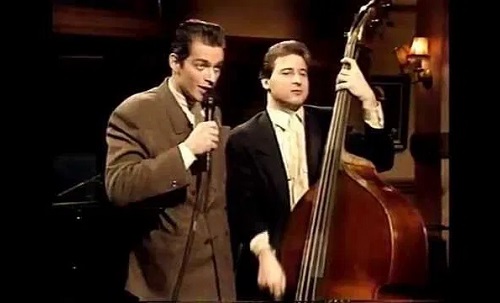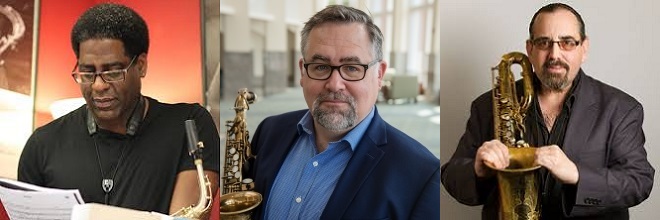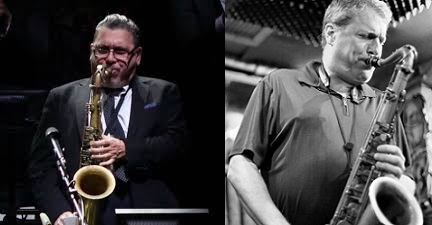The year 1993 holds a nostalgic set of feelings for me. I graduated high school with a certain degree of pride and wonder. I saw Nolan Ryan pitch his last game in my home town, as a member of the Texas Rangers. I started my college career, which would see me change the focus of my education twice before graduating graduating five years after I finished my high school career. Also, the album When My Heart Finds Christmas by Harry Connick Jr. of New Orleans, Louisiana made its debut.
 (Album cover for When My Heart Finds Christmas by Harry Connick Jr.).
(Album cover for When My Heart Finds Christmas by Harry Connick Jr.).
The album’s first song of Christmas music starts with Sleigh Ride, an orchestral standard composed by Leroy Anderson in 1948. The song, while making no explicit reference to Santa Claus or the holiday of Christmas, appears on many a Christmas album, including this one.
When My Heart Finds Christmas, the second song of the album and first written by Harry Connick Jr. to appear on the album of the same name, offers an allusion to love, affirmation and the good cheer of family, innocence and the effort to share the joy that such feeling engenders. The instrumentation, chorus, and uplifting spirit of this song are really magical.
 (Vocalist and piano player Harry Connick Jr., left, with bassist Ben Wolfe in 1989).
(Vocalist and piano player Harry Connick Jr., left, with bassist Ben Wolfe in 1989).
With (It Must’ve Been Ol’) Santa Claus, the original song penned by Harry Connick Jr. offers an upbeat timing and playful look into the heart of a young boy on the precipice of thinking Mom and Dad might be standing in for the jolly man himself. With the happy belief in Santa Claus preserved, coupled with a joyful “happy ho ho ho to you,” the experience is pure gold.
The fourth song from When My Heart Finds Christmas is The Blessed Dawn Of Christmas Day, penned along with a number of other songs on the album. The slower, more orchestral song bends more towards the spiritual aspects of considering the birth of Jesus Christ a blessing.
 (From Left, alto saxophonist Brad Leali, alto saxophonist Will Campbell and baritone saxophonist Dave Schumacher. Each played on the album When My Heart Finds Christmas).
(From Left, alto saxophonist Brad Leali, alto saxophonist Will Campbell and baritone saxophonist Dave Schumacher. Each played on the album When My Heart Finds Christmas).
In moving to holiday standard Let It Snow! Let It Snow! Let It Snow!, listeners get a jazzy impression which rejoices in a surprise impression in the first 20-seconds that sits well with me to this day. The original lyrics and arrangement date back to a song written by lyricist Sammy Cahn and composer Jule Styne in July 1945. In the southern hemisphere, where this song gets played in the summer months of the northern hemisphere, the song is less associated with the holidays.
The Little Drummer Boy arrives next with the distinctive sound of marching drums with orchestral backing. The song tells the sweet revelry of both a poor boy and Jesus Christ at his birth of offering the gift of music, which is the one true talent and happiness he has to bring as an expression of love and reverence. The wind instruments in support of this song are remarkable and appreciated.
 (Guitarist Russell Malone played on the album When My Heart Finds Christmas).
(Guitarist Russell Malone played on the album When My Heart Finds Christmas).
Showing off a traditional piano arrangement beginning with Ave Maria, a song my father’s mother loved even before her passing and this song’s release, the additional production adds nuance and subtlety. Originally offered by Franz Schubert and Sir Walter Scott, the song with Latin lyrics for the prayer Hail Mary bring a prayerful feeling.
Parade of the Wooden Soldiers returns a more playful mood brought to us from German operetta and light classical composer Leon Jessel, dating back to 1897. The whimsical, playful quality reminisces back to an early childhood of fantasy and happiness that brings a smile to my face.
What Child Is This? offers a traditional holiday hymn originally written by William Chatterton Dix, with lyrics taken from a poem written by the same man. A classic orchestral take strong with strings and singing, of course, by Harry Connick Jr. render a sweet extolling of the new birth of the baby Jesus.
Christmas Dreaming builds with Connick Jr. and chorus singing based on the song brought to us through composers Irving Gordon and Lester Lee. The tempo increases following What Child Is This?, and previews a more spiritually contemplative new track written by the namesake of the album When My Heart Finds Christmas. which raises the feeling with something that uplifts the feelings in the listener.
I Pray On Christmas offers a soulful, stronger gospel sound in introducing a brand new carol offered by Harry Connick Jr.. The song has appeared at least a half dozen times on albums by other performers since. This song is perhaps the last traditionally spiritual song on the album, though those moved by O Holy Night, which takes note of a moment without necessarily invoking a traditionally religious feeling, may have a different take.
 (Tenor saxophonist Jerry Weldon, left, and tenor saxophonist Ned Goold played on the album When My Heart Finds Christmas).
(Tenor saxophonist Jerry Weldon, left, and tenor saxophonist Ned Goold played on the album When My Heart Finds Christmas).
Rudolph the Red-Nosed Reindeer clearly gets into a more upbeat feeling, invoking the Johnny Marks song that was first a hit for Gene Autry. The song includes singing with children and Connick Jr., in addition to trumpet and other horns in accompaniment.
O Holy Night was first composed by Adolphe Adam in 1847 with an assist from the French poem Midnight, Christians written by poet Placide Cappeau. The lyrics reflect the notion that the birth of Jesus is a means for the spiritual redemption of humanity. Harry Connick Jr.‘s composition offers a reverential feeling for the song with a feeling that feels like an attempt to imbue fervor into the offering. The attempt aims high.
The song What Are You Doing New Year’s Eve? offers a tribute to 1947, the year of the first rendering of the song as well as the year of my mother’s birth. Frank Henry Loesser wrote the song for independent release rather than for a particular musical. The drum and saxophone play in Connick‘s offering, along with the strings, render a subdued, sleepy feeling to complete a warm blanket of peace to the jazzy feeling of the song.
The full experience of the album offers spiritual, secular, and holiday feeling. There is something for many in this album, and the offering lands somewhere distinctly more musical and more deeply whole than what I often hear through the distribution methods available today. Indeed, this is one holiday is one that I recommend you consider adding to your playlist this season.
Matt – Monday, December 9, 2019
